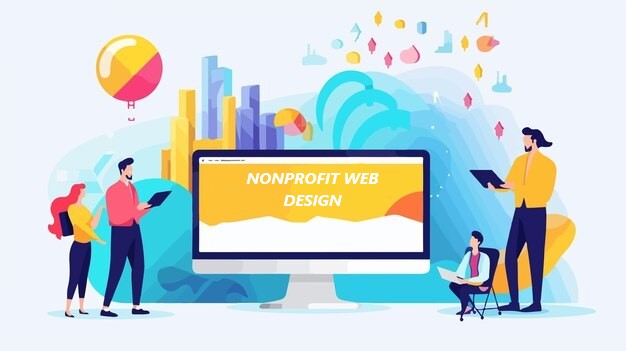How to Create a Nonprofit Web Design That Reflects Your Mission

Creating a nonprofit website that effectively reflects your mission is crucial in today’s digital landscape. The right web design can amplify your organization’s impact, engage supporters, and drive donations. However, achieving this requires more than just a visually appealing layout; it demands a thoughtful approach that communicates your values and goals. This guide will walk you through how to create a nonprofit web design that truly reflects your mission, highlighting how top nonprofit web design services can help you achieve this.
Understanding the Importance of Mission-Driven Nonprofit Web Design
Mission-driven web design ensures that every element of your website communicates your organization’s purpose. From the imagery you choose to the language you use, your website should resonate with your mission and values. Top nonprofit web design services understand the significance of aligning design with mission and can guide you through this process.
- Why Mission Matters: Your mission is the heart of your nonprofit. A website that reflects this helps build trust and connect with your audience.
- First Impressions Count: The design of your website is often the first point of contact with potential supporters. It must leave a lasting, positive impression.
- Drive Engagement: Mission-driven design encourages visitors to explore more, get involved, and support your cause.
Key Elements of a Mission-Reflecting Nonprofit Web Design

To create a website that reflects your nonprofit’s mission, it’s important to focus on specific design elements that resonate with your audience. Top nonprofit web design services incorporate these elements to create a cohesive and impactful design.
- Compelling Visuals: Use images and videos that showcase your work, the people you help, and the impact of your mission.
- Authentic Storytelling: Share real stories that highlight your nonprofit’s journey and achievements. This builds an emotional connection with visitors.
- Clear Call-to-Actions (CTAs): Strategically place CTAs that encourage visitors to take action, such as donating, volunteering, or subscribing to your newsletter.
How Top Nonprofit Web Design Services Approach Mission Integration
Top nonprofit web design services employ strategic planning to ensure that your mission is central to your website design. Here’s how they do it:
- Mission Discovery Sessions: Before designing your website, top nonprofit web design services conduct in-depth sessions to understand your mission, vision, and goals.
- Audience Analysis: Understanding your target audience is key. Top nonprofit web design services analyze your audience’s needs to tailor your website accordingly.
- Design That Speaks Your Values: From color schemes to typography, every design choice is made to reflect your nonprofit’s unique identity.
Designing a Home Page That Reflects Your Mission
Your home page is the most visited part of your website and should immediately convey your mission. Top nonprofit web design services focus on creating an engaging and mission-driven home page.
- Mission Statement Highlight: Place your mission statement prominently on the home page. Use concise and powerful language that captures the essence of your nonprofit.
- Impact Visuals: Use impactful visuals such as images, videos, or infographics that tell your story. This visual storytelling helps to quickly convey your mission.
- Showcase Key Programs: Highlight the key programs and initiatives that drive your nonprofit. This helps visitors understand how you fulfill your mission.
The Role of Content in Reflecting Your Nonprofit’s Mission
Content plays a crucial role in mission-driven nonprofit web design. Top nonprofit web design services ensure that your content is not only informative but also emotionally engaging.
- Mission-Focused Content Strategy: Every piece of content on your website should be connected to your mission. Whether it’s a blog post, news update, or event announcement, ensure it reinforces your nonprofit’s purpose.
- Storytelling Blogs: Use blog posts to dive deeper into your mission and share stories of impact. Highlight how your programs are making a difference in the community.
- Engaging Copywriting: The language used on your website should resonate with your audience. Top nonprofit web design services use persuasive and compassionate language that inspires action.
Creating an Impactful Donation Page
One of the most critical pages on a nonprofit website is the donation page. A well-designed donation page can significantly increase your fundraising efforts. Top nonprofit web design services ensure that this page is both user-friendly and aligned with your mission.
- Clear and Simple Design: A clutter-free design with a clear call-to-action makes it easy for visitors to donate.
- Mission-Focused Messaging: Reinforce your mission on the donation page. Let donors know exactly how their contributions will make an impact.
- Trust Elements: Include trust badges, testimonials, and transparency about how funds are used. This builds donor confidence and encourages more contributions.
Leveraging Visual Branding to Reflect Your Mission
Visual branding is more than just a logo; it’s the entire visual language of your nonprofit. Top nonprofit web design services help create a cohesive brand that reflects your mission.
- Consistent Color Palette: Use colors that resonate with your mission. For example, green often represents growth and sustainability, while blue can convey trust and reliability.
- Typography That Speaks: Choose fonts that are easy to read but also reflect your nonprofit’s tone—whether it’s bold and impactful or gentle and compassionate.
- Logo Integration: Your logo should be prominently displayed across your website. It serves as a visual anchor that continually reminds visitors of your brand.
Optimizing Nonprofit Web Design for Accessibility
An accessible website ensures that everyone, regardless of ability, can access and engage with your content. Top nonprofit web design services prioritize accessibility to make your website inclusive.
- Alt Text for Images: Every image should have descriptive alt text that conveys its content to visually impaired users.
- Keyboard Navigation: Ensure that all website elements can be navigated using a keyboard, catering to users with mobility issues.
- Readable Text and High Contrast: Use high-contrast color schemes and readable font sizes to ensure that your content is easy to consume for all users.
Incorporating Social Proof to Build Credibility
Social proof, such as testimonials, success stories, and partnerships, helps build credibility and trust in your nonprofit. Top nonprofit web design services strategically place social proof elements throughout your website.
- Testimonials and Donor Stories: Share testimonials from those who have benefited from your programs or donors who believe in your mission.
- Partnerships and Collaborations: Highlight any partnerships with well-known organizations. This showcases your nonprofit’s credibility and impact.
- Impact Metrics: Use numbers and statistics to show the tangible impact of your work. For example, “500 families served” or “10,000 meals provided” can quickly communicate your mission’s success.
Enhancing User Experience with Top Nonprofit Web Design Services

User experience (UX) is a critical aspect of web design. A website that is easy to navigate keeps visitors engaged and encourages them to explore more about your mission.
- Intuitive Navigation: Top nonprofit web design services ensure your website is easy to navigate, with clear menus and organized content.
- Fast Loading Times: A slow website can deter visitors. Optimizing images and using efficient coding practices are essential for keeping your website fast and user-friendly.
- Mobile Responsiveness: With a significant portion of users accessing websites via mobile, it’s vital to have a mobile-friendly design that looks great on any device.
Using Analytics to Measure Your Mission’s Reach
Measuring the effectiveness of your website is crucial to understanding how well it reflects your mission. Top nonprofit web design services help you set up analytics to track visitor behavior and engagement.
- Tracking Engagement: Use tools like Google Analytics to see which pages are most visited, how long visitors stay, and what actions they take.
- Conversion Metrics: Monitor the performance of donation forms, volunteer sign-ups, and other conversion points.
- Adjusting Based on Data: Use the insights from your analytics to make data-driven decisions about design and content updates.
Partnering with Top Nonprofit Web Design Services for Ongoing Success
Creating a mission-reflecting website is not a one-time task; it requires ongoing updates and optimization. Partnering with top nonprofit web design services ensures your website continues to evolve with your organization’s needs.
- Regular Content Updates: Keep your website fresh with regular updates about your work, events, and successes.
- Ongoing SEO Optimization: Maintain your website’s visibility in search engines by continually optimizing your content and technical SEO.
- Technical Support and Maintenance: Ensure your website remains secure, functional, and up-to-date with professional support from top nonprofit web design services.
Conclusion
Creating a nonprofit web design that reflects your mission is essential for connecting with your audience, building credibility, and driving action. By focusing on mission-driven elements, leveraging content and visuals, and partnering with top nonprofit web design services, you can create a powerful online presence that amplifies your impact. Remember, your website is more than just a digital space—it’s a platform to share your mission, engage supporters, and inspire change.





